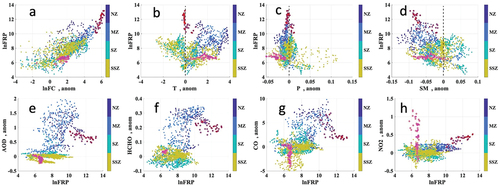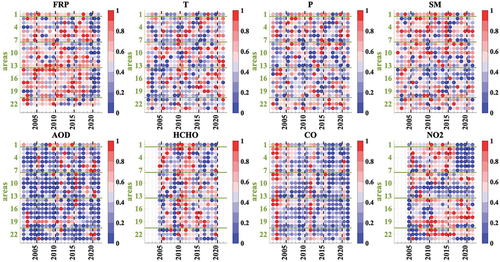Figures & data
Figure 1. PEEX domain, selected areas, and selected locations. Background – land types map (https://lpdaac.usgs.gov/products/mcd12c1v006/, last access 25.08.2023). Coordinates of the selected areas are provided in the supplement (Table S2).
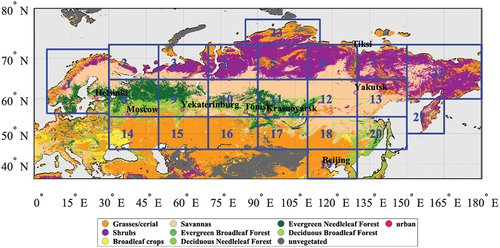
Figure 2. Cumulative FRP (MW, 106) over the summer season (May to August) over the PEEX domain for 2002–2022 obtained from the MODIS instrument.
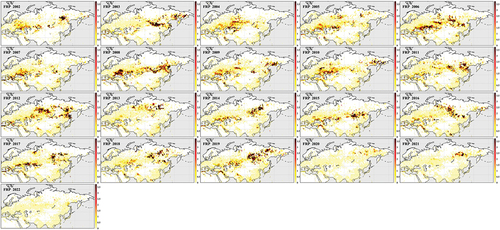
Figure 3. For AOD, HCHO, CO, and NO2 (panels left-right), background monthly values (May to August, panels top-down) obtained from 2002–2022 (for AOD and CO; 2005–2020 for HCHO; 2005–2022 for NO2) monthly products.
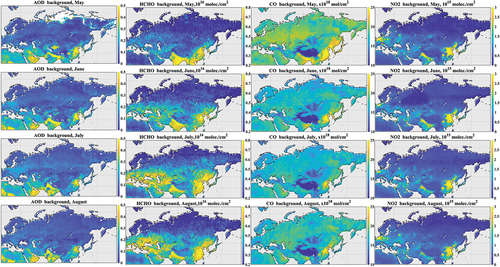
Figure 4. For July 2002–2022, mean actual values (upper panel) for lnFRP (a), T (b), P (c), SM (d), AOD (e), HCHO (f), CO (g), and NO2 (h) and mean monthly values (lower panel) for the same variables after removal of the background values (except for lnFRP, which remains unchanged).
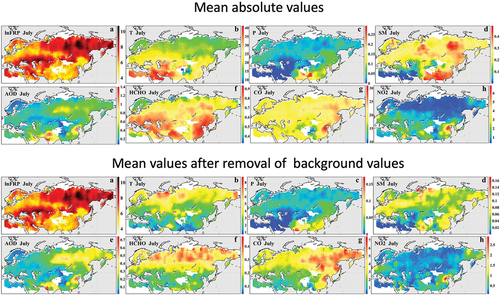
Figure 5. Mean lnFRP for July 2002–2022. (a) Spatial distribution of the correlation coefficients (p-value < 0.05) between lnFRP and temperature, T (b), precipitation, P (c), soil moisture, SM (d), AOD (e), HCHO (f), CO (g), and NO2 (h) for July 2002–2022.

Table 1. For July, for the whole PEEX domain and different land types, the mean statistically significant (p < 0.05) correlation coefficients between lnFRP and T, P, SM, AOD, CO, HCHO, and NO2.
Figure 6. For May Citation2006 (intense cropland fires in southern Russia and Kazakhstan), satellite lnFRP and ERA5 anomalies of meteorological parameters (T, P, and SM), satellite AOD and gas emission (HCHO, CO, NO2) calculated with respect to median (2005–2017) values.

Figure 7. For August Citation2013 (intense fires in Siberia and eastern Europe), same as .

Figure 8. For August Citation2013, scatter plots of lnFC versus lnFC(a), meteorological parameters (temperature, (b); precipitation, (c); soil moisture, (d)), AOD (e), HCHO (f), CO (g), and NO2 (h) with colour showing the latitude dependence (colourbar, latitudinal zones). Red dots correspond to the Sakha (Russia) area; magenta dots correspond to Jinan (China) area.
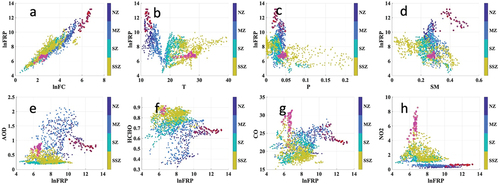
Table 2. For August Citation2013, correlation coefficients between different variables (Var1, Var2, actual values, and anomalies) for four zones (NZ, MZ, SZ, and SSZ) defined in Sect. 2. Statistically not significant values are replaced with *.
Figure 10. Temporal and spatial distribution of FRP, temperature (T), precipitation (P), soil moisture (SM) (upper panel), and AOD, HCHO, CO, and NO2 (lower panel) for July. The Y-axis shows the Areas (1–23) defined in , while the X-axis shows the time (years). Vertical black dashed lines separate 5-year periods (e.g. 2006–2010 from 2011–2015), whereas horizontal green lines divide different latitudinal zones. Values for the variables are shown as a colorbar. The colorbar comprises of four primary colours (blue-green-magenta-orange, from low to high values). Each colour (e.g. blue) is divided into sub-classes of different intensities, increasing from lower to higher (inside sub-class) values.
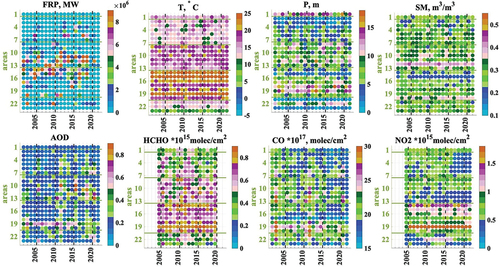
Table 3. For different domains, correlation coefficients between lnFRP and temperature (T), precipitation (P), soil moisture (SM), AOD, CO, HCHO, NO2 for actual values (actual), anomalies (anom), relative anomalies (rel. anom), and scaled anomalies (scaled anom). Same after background values (BG) have been removed. Values are replaced with * if the corresponding p-value is >0.05.
Figure 12. For central Siberia (Area 11), upper panel: scatterplots for lnFC, temperature (T), precipitation (P), and soil moisture (SM) monthly relative anomalies (x-axis) for years 2002–2022 and FRP relative anomalies (y-axis). Lower panel: scatterplots for different combinations of lnFRP relative anomalies (x-axis) and AOD, CO, HCHO, and NO2 (y-axis) relative anomalies. Pearson correlation coefficient R is given on top of each panel; the p-value is provided. Percentages of points (from the total number of points) are shown in the “expected” quarters (e.g. for precipitation and soil moisture “expected” quarters are sector 90º–180º (T< 0or p < 0, and FRP > 0, coloured light yellow) and sector 270º–360º (T> 0 or p > 0, FRP < 0, coloured light orange); for other variables “expected” quarters are sector 0º–90º (anomalies are positive for both variables, coloured light red) and sector 180º–270º (anomalies are negative for both variables,coloured light blue)). The colour of the dots shows the month (see the legend).
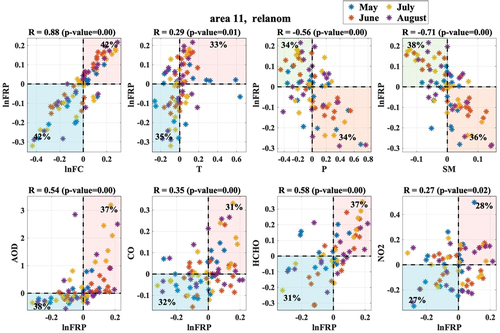
Figure 13. For central Siberia (Area 11), upper panel: scatterplots of scaled lnFC, T, P, SM (x-axis), and scaled FRP (y-axis). Lower panel: scatterplots scaled FRP (x-axis) and scaled AOD, CO, HCHO, and NO2 (y-axis). The Pearson correlation coefficient R is shown on top of each panel. The color of each fit shows the month (see the legend).
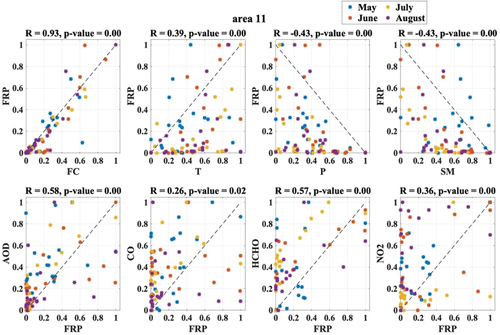
Figure 14. Decadal trends of FC, FRP, meteorological parameters, AOD, and atmospheric gases for the whole PEEX domain, zones NZ, MZ, and SZ, and Areas 1, 11, and 19. Units are as in .
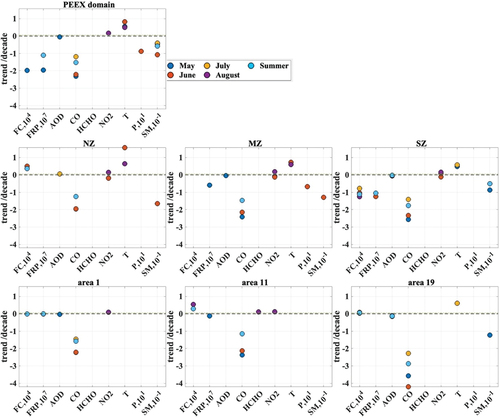
Figure 15. Top panel: AOD:CO ratios of monthly satellite data for pixels with FRP>0 (left); PM2.5:CO from Akagi et al. (Citation2011) (middle); PMFRP:CO as in SILAM (right). Middle panel: same for AOD(or PM):HCHO. Lower panel: same for AOD(or PM):NO2(or NO, NOx).
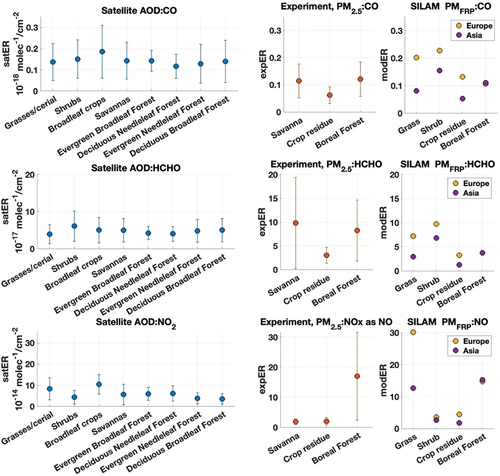
Figure 16. For three latitudinal zones (>65°N, 55°N–65°N, <55°N, columns left to right), satER for AOD:CO, AOD:HCHO, AOD:NO2 (panels top-down).
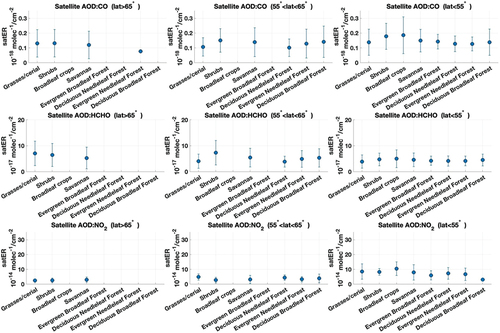
Figure 17. For different AOD ranges (all AOD, AOD ≤0.5, AOD ≥0.5, columns left to right), satER for AOD:CO, AOD:HCHO, AOD:NO2 (panels top-down).
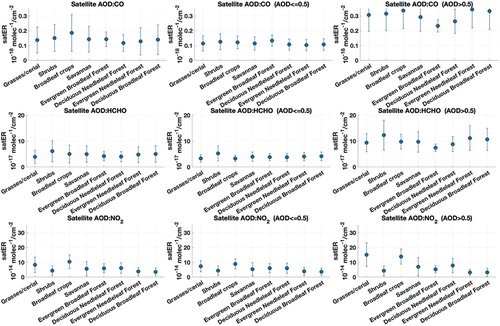
Figure 18. Boxplot of seasonal (May–August) columnar BC concentrations inferred from AERONET measurements for the following sites: Helsinki, Moscow, Yekaterinburg, Tomsk, Yakutsk, and Beijing. Boxplots give the seasonal medians (with 5th/95th percentiles) of BC concentrations, and red points provide the mean values in addition. The numbers below the boxes indicate the total number of measurements included in the seasonal means/medians in each year.
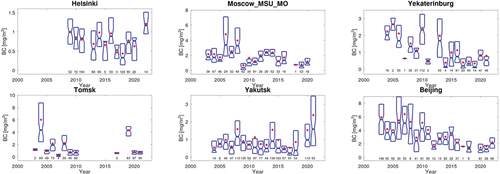
231128_PEEXms_v7_supplement-0204.docx
Download MS Word (25.3 MB)Data availability statement
Larisa Sogacheva (Citation2023). Satellite-retrieved AOD, CO, HCHO, and NO2 background over the PEEX domain [Data set]. Finnish Meteorological Institute. https://doi.org/10.23728/FMI-B2SHARE.003652E36B1B4FABA14283DE53C50B61

